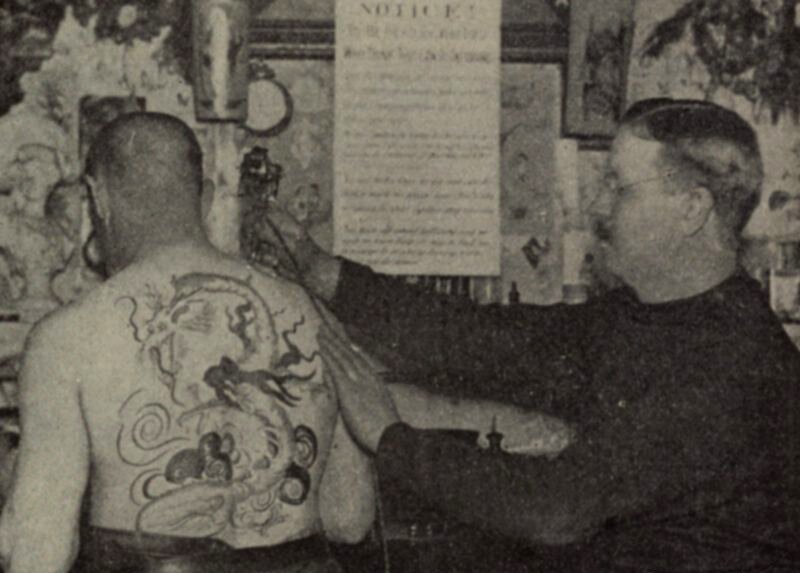New York City is widely regarded as one of the global hubs of tattoo culture. The city’s rich history of tattooing dates back over a century, to the early 1900s, when tattoo art began to gain widespread popularity.
The First Tattoo Shop in NYC
New York City is home to the very first tattoo shop in the United States, which opened in the early 1870s. This pioneering tattoo parlor was founded by Samuel O’Reilly, who is widely considered one of the forefathers of modern tattooing. O’Reilly opened his shop at 11 Chatham Square in Manhattan. He was also the first person to patent the electric tattoo machine in 1891, a device that revolutionized tattooing by making the process faster and more efficient. His tattoo machine was based on Thomas Edison’s electric pen, and its invention laid the foundation for modern tattoo practices.
For decades, O’Reilly’s tattoo shop became a beacon for sailors, soldiers, and adventurous New Yorkers looking to get inked. Tattooing was deeply connected to maritime culture, with many of the early tattoos featuring nautical themes like anchors, ships, and mermaids.

The Tattoo Ban (1961 – 1997)
Interestingly, tattooing wasn’t always legal in New York City. From 1961 to 1997, the city implemented a ban on tattooing due to health concerns, particularly the outbreak of hepatitis. However, the ban didn’t stop the art from thriving. During this period, tattooing moved underground, with tattoo artists working from their homes or makeshift studios. Despite these challenges, the demand for tattoos only grew, and the underground scene became an integral part of NYC’s tattoo history.
In 1997, the tattoo ban was finally lifted, and tattoo artists were able to open legal, regulated shops. This marked the beginning of a new era for the tattoo industry in NYC, as shops began to pop up throughout the five boroughs, helping the city become a global tattoo destination.
Tattoo Traditions in NYC
Tattooing in New York City has always been deeply rooted in tradition, and certain styles have come to define the city’s tattoo culture.
Traditional American (Sailor Jerry Style)
One of the most iconic styles associated with NYC is the Traditional American style, also known as the Sailor Jerry style. This style is characterized by bold black outlines, simple shading, and vibrant colors, often depicting classic images like anchors, eagles, skulls, and hearts. Sailor Jerry (Norman Collins) was a prominent figure in the mid-20th-century tattoo scene and was known for elevating traditional American tattooing by adding new techniques and improving sterilization standards.
Japanese Irezumi
Japanese Irezumi, another popular style in NYC, reflects the rich tradition of Japanese tattooing, featuring detailed, flowing designs that depict mythological creatures like dragons, koi fish, and samurais. This style became widely popular in the city as NYC’s diverse population embraced and celebrated different cultural tattoo forms.
Black and Grey Realism
The black and grey realism style also holds a significant place in New York’s tattoo culture. This style emphasizes detailed shading and smooth transitions to create realistic portraits and lifelike images. Many talented artists in NYC specialize in this style, creating stunning works of art that range from celebrity portraits to intricate landscapes.
Tattooing in NYC Today
In the present day, NYC’s tattoo scene is thriving more than ever. With the ban long lifted, the city is now home to hundreds of tattoo shops, each offering a variety of styles and specialties. Some of the city’s top tattoo shops are known globally for their skilled artists, professional atmosphere, and adherence to the highest safety standards.
New York City hosts major tattoo conventions, including the New York City Tattoo Convention, which brings together some of the best tattoo artists from around the world to showcase their work. These events provide a platform for tattoo enthusiasts to discover new artists, learn about trends, and even get inked by world-renowned tattooists.
Famous NYC Tattoo Shops
Many of NYC’s most famous tattoo shops have played a key role in shaping the city’s tattoo culture. Fineline Tattoo, one of the city’s oldest continually operating tattoo parlors, has been serving clients since the ban was lifted in 1997. Other notable shops include Bang Bang Tattoo, which is known for its celebrity clientele, and Kings Avenue Tattoo, home to some of the best-known artists in the industry.
The Future of Tattooing in NYC
The future of tattooing in New York City looks promising, with new trends, techniques, and styles constantly emerging. With advancements in technology, tattooing is becoming more precise, and the industry is seeing a surge in demand for minimalist and fine line tattoos, which focus on subtle details and thin lines.
The acceptance of tattoos in mainstream society has also grown significantly. Tattoos, once seen as countercultural, are now more common than ever, with people from all walks of life getting inked. This growing acceptance is helping fuel the industry’s continued expansion, as tattooing becomes more accessible and diverse.
Additionally, the rise of tattoo removal services is opening up new opportunities for those who want to revise or completely remove their tattoos. Innovations in laser removal technology are allowing for safer and more effective tattoo removal, offering clients greater flexibility when it comes to their body art.
In terms of regulations, the NYC Health Department closely monitors tattoo shops to ensure that they meet hygiene and safety standards, ensuring that the industry remains safe and professional.
In Conclusion
New York City’s tattoo culture has a rich and fascinating history that dates back to the 19th century, from Samuel O’Reilly’s pioneering tattoo shop to the thriving, vibrant scene we see today. The city is home to a diverse range of tattoo styles, with artists constantly pushing the boundaries of what can be achieved with ink.
Whether you’re interested in a traditional tattoo or something more modern, NYC is one of the best places in the world to get inked. The combination of history, tradition, and future innovation ensures that New York will remain at the forefront of global tattoo culture for years to come.
